How to survive: Nuclear fallout

Survival expert shares tips on how to prepare and survive a nuclear attack
There has been an uptick in fear about a possible nuclear war with heightened tensions in the war in Ukraine. The real question is if one does happen, are you prepared?
LOS ANGELES - 'How to Survive' is a series where experts explain how to survive everything from natural disasters to everyday issues that affect us all.
The peril of nuclear war — and its aftermath — has been an ominous threat looming over mankind since the 1940s. While the politics and the players may have changed through the years, the one constant has been the sheer destructiveness of the weapons.
Now, many Americans are, for the first time in their lives, contemplating the possibility of a nuclear attack and how to survive it.
"If anything like [a nuclear attack] does happen – defense systems fail, nukes that large hit the United States – it's going to be really, really terrible," said Thomas Coyne a professional survival instructor who teaches courses at and owns California Survival Training.
What is nuclear fallout?
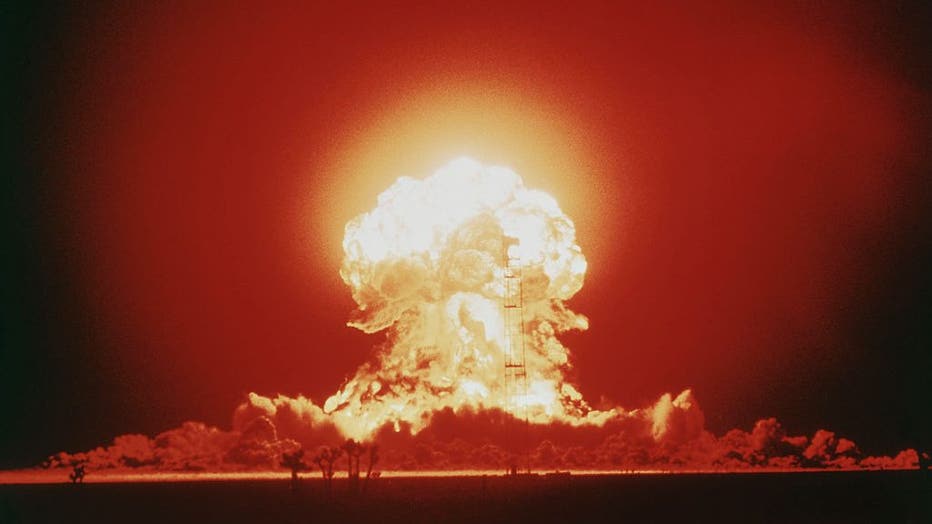
Nuclear bomb blast. (Photo by Lambert/Getty Images)
In the event of a nuclear attack, the initial explosion may actually be the least of your worries. According to the Environmental Protection Agency, when a nuclear weapon is detonated aboveground, radioactive materials are sent high into the atmosphere up to 50 miles.
Those radioactive particles that fall back down to Earth are called fallout. If a nuke were to ever hit a city, or cities, the fallout could envelop the planet with help of weather patterns that would spell doom for humanity.
This might spark fear over just a single detonation, but nuclear weapons have been tested since the first one exploded on July 16, 1945.
Since then, at least eight nations have detonated over 2,000 nuclear tests at underground and atmospheric test sites across the globe.
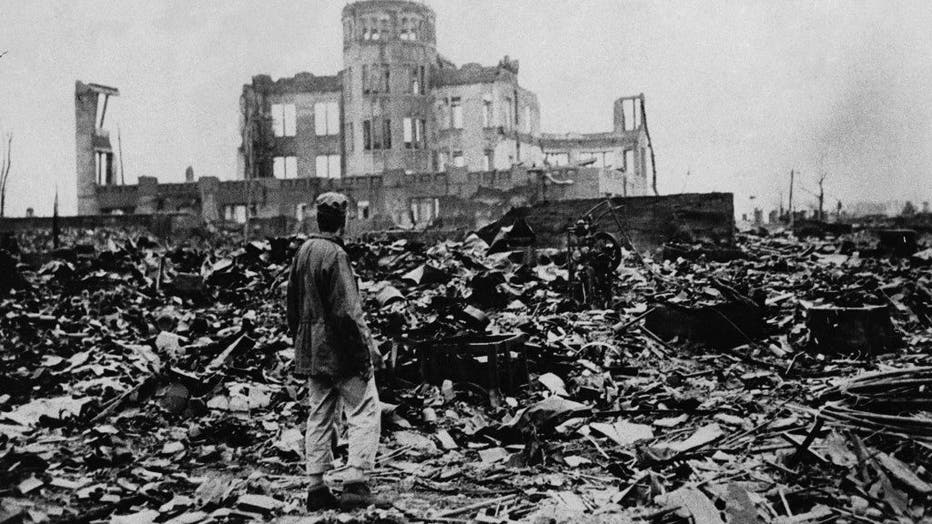
World War II, after the explosion of the atom bomb in August 1945, Hiroshima, Japan. (Photo by: Photo12/Universal Images Group via Getty Images)
Are we prepared?
The short and unfortunate answer is: Not really.
The U.S. is not prepared for the aftermath should an adversary or the terrorist decide to detonate a nuclear bomb in a major city or multiple major cities in the country, and that’s according to multiple institutions.
There are six cities that would likely be the target of a nuclear attack according to a 2018 report by Columbia University’s Center for Nuclear Studies. Those include New York, Chicago, Washington D.C., Los Angeles, San Francisco, and Houston.
The reason these cities are targets is because they are homes to some of the most critical infrastructure for the entire country, such as health, defense and communications systems.
And despite websites from health and government agencies such as the Centers for Diseases Control and Prevention or FEMA advising civilians to "get inside, stay inside and stay alert," most are not ready for the aftermath of a nuclear attack.
Speaking with FOX TV Stations, Coyne had both hopeful and grim predictions in the event a nuclear attack hits U.S. soil.
"It's going to be really, really terrible. I don't care how well-prepped you are," he warned.
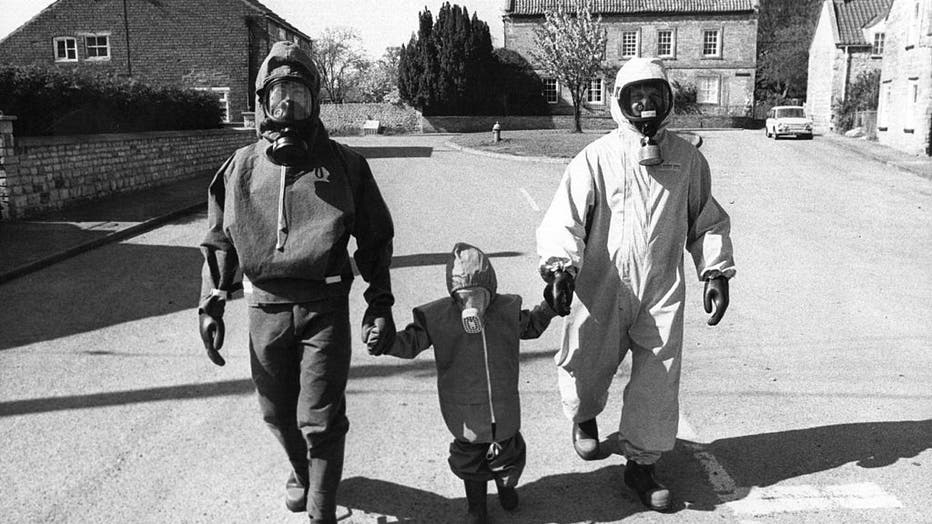
File: A family wearing anti-radiation suits in the village of Wellingore, Lincolnshire, the home of Civil Defence Supply, a mail-order business that supplies products to survive a nuclear attack, in 1980. (Photo by Ian Tyas/Keystone Features/Getty Im
With tensions between the U.S. and Russia at an all-time high, a former U.S. Defense Intelligence Agency agent and author of "Putin's Playbook: Russia's Secret Plan to Defeat America" said that while the U.S. does have a strategic plan should something happen, recent responses to Russia’s aggression instill little confidence that the United States is doing the necessary preparation for such an outcome.
"Judging by our overall response and that we put all our eggs in one basket with sanctions and we were caught off guard regardless of the fact Putin never made it a secret what he was going to do yet we are grasping at straws," Rebekah Koffler said. "Given that, it doesn’t seem that we are prepared for the possibility of him using nuclear weapons."
This comes after a report was released in 2014 by the nonpartisan Government Accountability Office that found government agencies don’t know how to handle truly huge disasters.
The report looked into the investigation of FEMA’s response to 2012's Superstorm Sandy, and determined FEMA didn’t always keep track of disaster efforts by agencies, hampering the nation’s preparedness.
As to natural catastrophes, the report said FEMA should take a bigger responsibility in leading a coordinated response, setting clear minimum standards for agencies and collecting regular status reports. It said the Energy Department did not effectively coordinate with state agencies and the private sector during Sandy, which was blamed for at least 182 deaths and $65 billion in damage.
It also cited a lack of coordination among federal agencies in deciding whether to send law enforcement personnel to the affected region.

This photo taken on October 15, 2022 shows a portable toilet and daily necessities such as water and food in an underground nuclear bunker in Japan. (Photo by KAZUHIRO NOGI/AFP via Getty Images)
And that was the U.S. response to a major hurricane, something that is somewhat of a predictable and natural occurrence, so imagine if a sudden nuclear attack were to happen.
But FEMA and government agencies are not the end-all be-all.
Non-government agencies such as the Red Cross, Team Rubicon Disaster Response, and even civilian groups such as the Cajun Navy have created a linear strategy to get boots on the ground to where help is needed as soon as possible, Coyne said.
"So I'm a Red Cross volunteer and I'm a Team Rubicon volunteer. So as soon as anything like that happens, those people are being mobilized right away," Coyne continued. "And locals, CERT teams are getting mobilized right away. There's going to be people that want to help. Remember when New York had that blackout and everybody just kind of walked through, they were like, 'Oh, there's going to be looting and chaos and cats and dogs living together,' right? But no, it was none of that. They just went about their days and all these spontaneous block parties and stuff started up."
So, no, the U.S. is not really prepared for what happens after a nuclear attack, but, we can all have some faith in humanity that we will rally together to help one another and hope that our neighbors to the north or south, will be willing to give us a hand.
How to prepare
Suffice it to say, if someone decided to drop a nuclear weapon on us, the outcome won’t be wonderful, but there are ways that one can prepare for such a disaster, even if that preparation is something as simple as buying water ahead of time.
Now, we aren’t saying you should go and panic-buy all the water you can find, but it doesn’t hurt to just be prepared for anything. A particularly nasty natural disaster could knock out your power for a few days, sometimes weeks, and having something as essential as water and basic medical supplies could make or break a dire situation.
Here are the top few items Coyne advised everyone should have in their residence in the event of any kind of natural disaster or even a nuclear fallout situation.
Have a plan
For anything in life, being prepared is the key to avoiding potentially deadly mistakes, especially if a nuclear attack were to befall the U.S.
"I'd say the most important thing first is a solid plan," Coyne said. "You're going to want to be able to evacuate the area. If there's fallout reaching your area, you simply don't want to stick around."
Get a solid route ready for you and your family or loved ones to travel should you need to get away from a target area and identify any designated bomb shelters if your municipality has one, according to Ready.gov.

How you should prepare for a nuclear attack
Here are the top few items survival expert Thomas Coyne advised everyone should have in their residence in the event of any kind of natural disaster or even a nuclear fallout situation.
Emergency supply kit
It doesn’t matter if it’s a nuclear attack or a natural disaster, having an emergency supply kit ready in your residence could make or break a potentially deadly situation.
It would be tough, and probably unwise, to literally prepare for the end of the world, but typically, for a major emergency, you need at least a few things in your kit.
Apart from the typical non-perishable food items, water, medications and batteries that typically are needed during a crisis situation, here are some specific items you will need that are unique to a nuclear fallout situation.
Potassium iodide pills: These pills can help block the absorption of harmful radiation by the thyroid gland if taken just before or immediately after exposure to nuclear radiation.
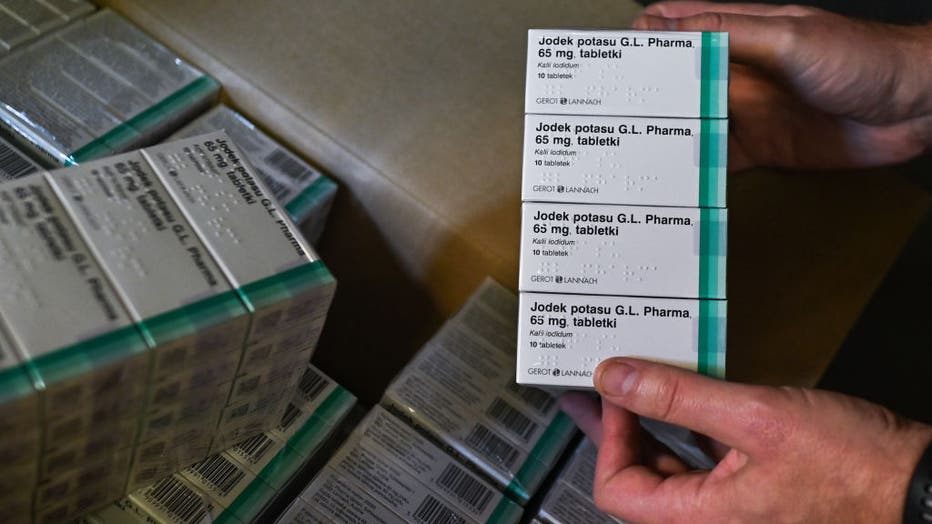
A local firefighter opens a box of iodine tablets in Milanowek Fire station, one of the distribution points, in Milanowek, Poland on October 10, 2022. (Photo by Artur Widak/Anadolu Agency via Getty Images)
CBRN respirator: CBRN (chemical, biological, radiological, and nuclear) air-purifying respirators are bulky and come with air-purifying canisters that protrude from the face.
"This will stop the fallout," Coyne said. "You get a good seal on the mask, this will stop the fallout from getting in your lungs."
Map: Your GPS on your phone (and probably also your phone) will be useless if a full-scale nuclear attack took place in the U.S. So be sure to have an up-to-date and physical map handy should you have to venture out to get somewhere safe.
Hazmat/Tyvek suit: You don’t really need the entire getup that you see when crews work a hazardous materials incident. A Tyvek suit that people wear when they paint houses or the like will work just fine.
"But if you don't have anything like that, put on long sleeves, avoid skin contact and have breathing protection," Coyne advised.
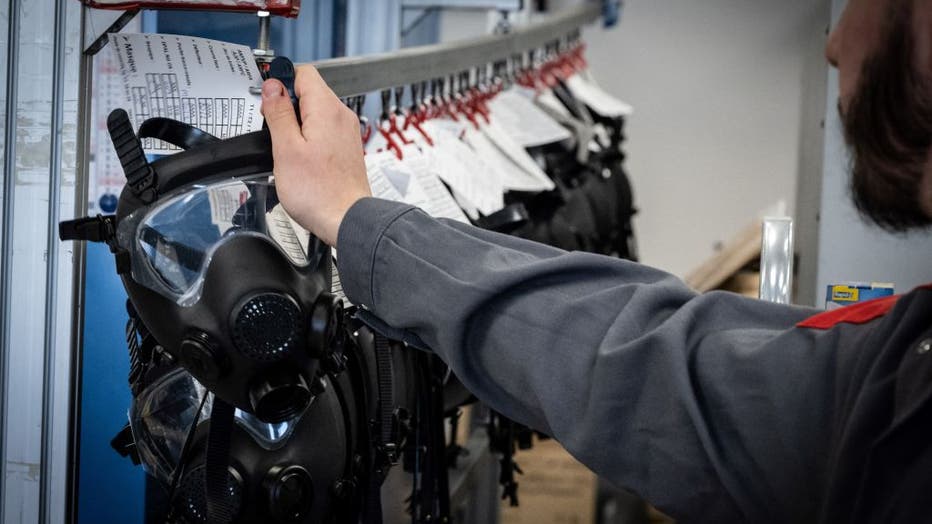
A technician from NBC Sys, a subsidiary of the French ammunition manufacturer Nexter Group, manufacture chemical, biological, radiological or nuclear (CBRN) protection masks in the group's factory of Saint-Chamond on February 13, 2023. (Photo by JEAN
What if you can’t leave?
If for some reason, you are unable to leave and are stuck where you are, you will definitely want to ensure you prevent any outside air from moving inside.
Let’s hypothetically say the bomb went off — boom — and you’re still at home. You managed to survive and now it’s the aftermath.
The biggest and immediate concern you will need to deal with is the nuclear fallout. Coyne says the first thing that needs to happen, as uncomfortable as it may sound, you’ll need to shut off your central air conditioning systems.
"You don't want to be sucking any of the outside air, in. So any of those ventilation systems that we normally use in our homes, we want to keep those shut, we want to keep our windows shut. You can duct tape the plastic over your windows if you're trying to reinforce your house; HEPA filter, whatever, because HEPA filters get out really small particles. Right. And the dust, the dirt, those are fairly large particles, right? So we shut off all external ventilation and try and let as little outside air in as possible," Coyne said.

True-color satellite image of Oceania with country borders and major rivers. (Photo by Planet Observer/Universal Images Group via Getty Images)
And in the event you survive a nuclear blast and are ready to venture outdoors once again, Coyne believes a vehicle with four-wheel drive is the best bet to get around any major obstacles.
It’s also important to note wind patterns. If you’re traveling in a post-nuclear attack world, you will want to travel perpendicular to the winds, Coyne noted.
"The wind's blowing east to west, I want to go south. It's blowing north and south, I'm headed east. I want to know where those wind directions are and I want to get out of there as soon as possible," Coyne said.
LINK: Click here for a real-time world radiation map
And, if you’re somehow ahead of the curve and can fly out of the country to a safer destination, scientists have designated five island nations that would be the safest places should a nuclear attack occur.
Researchers at the University of Otago and Adapt Research in New Zealand said Australia, New Zealand, Iceland, the Solomon Islands, and Vanuatu would have the best potential to produce food and potentially help rebuild civilization if a nuclear war were to occur.
Health risks of nuclear fallout
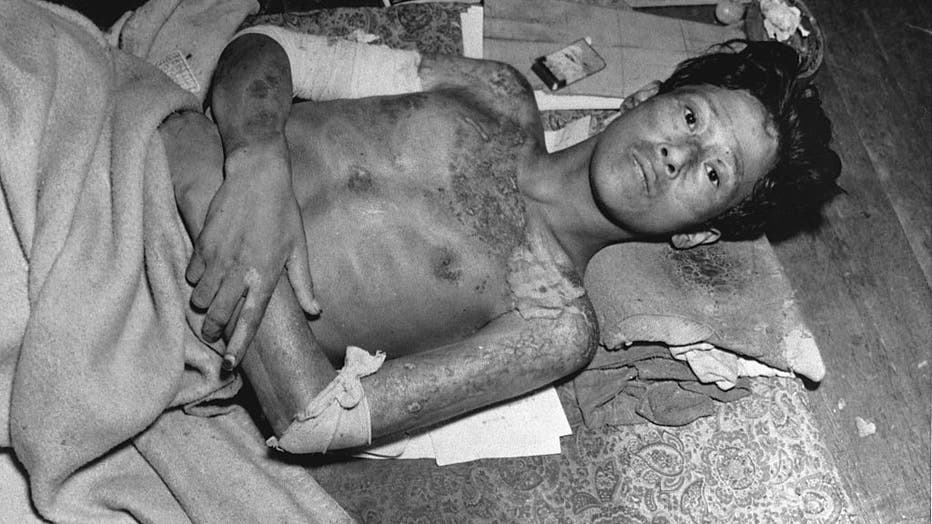
A young man lies on a mat with burns covering his body, after falling victim to the explosion of the atom bomb over Nagasaki, Japan. 1945. (Photo by CORBIS/Corbis via Getty Images)
The atomic bomb that exploded over Hiroshima nearly 80 years ago didn't just kill and maim. Historical accounts describe how many survivors have lived for decades with lingering shame, anger and fear as a result of the event. Many in Japan came to believe that radiation sickness from the bombing was infectious or hereditary.
It wasn’t until July 29, 2020, that a Japanese court, for the first time in the country’s history, officially recognized people exposed to the radioactive "black rain" that fell after the attack as atomic bomb survivors. The court ordered the city and the prefecture to provide the same government medical benefits to these individuals as are given to other survivors.
While there are anecdotal stories of people who somehow survived the Chernobyl disaster or the Hiroshima bombings, the CDC lists how fallout can impact the human body. In most cases, the worst is likely for those who don’t take the proper precautions.
Exposure to large doses of external radiation will likely cause death within a few days or months, the agency warns.
External exposure to lower doses of radiation and internal exposure from breathing or eating food contaminated with radioactive fallout may lead to an increased risk of developing cancer and other health effects.
Overall, the effects of a nuclear blast on a person depend on the size of the bomb but due to the horrible effects of radiation and fallout, it’s best to just get as far away from the impacted area as fast as you can.
The CDC writes that casualties will come from a variety of causes. The explosion itself, the fires after, the highly radioactive fallout in the first several days. Cancer will also be seen as a delayed effect of the fallout and will occur in people for years to come.
We’ve survived this before
There have been several instances of fallout which could have spelled the end for civilization as we know it, but only twice has there ever been an attack with weapons of this nature in history.
Hiroshima and Nagasaki atomic bombings

On this day in 1945, the United States dropped an atomic bomb on the Japanese city of Hiroshima
A subsequent bombing of Nagasaki would prompt the Japanese to surrender in World War II.
In 1945, the U.S. attack on Hiroshima, Japan killed 140,000 people. Three days later, a second atomic bomb was dropped on the Japanese city of Nagasaki, killing 70,000 and prompting Japan to surrender in World War II.
The unprecedented, destructive power of the bombs razed buildings and left lifelong physical and psychological scars on survivors. "Practically all living things, human and animal, were literally seared to death," read an Associated Press story from the time of the attacks.
The atomic bomb was dropped on Hiroshima just a month after the weapon was first officially tested.
An excerpt from an Associated Press report from Aug. 6, 1945 — the day the first bomb was dropped:
An atomic bomb, hailed as the most terrible destructive force in history and as the greatest achievement of organized science, has been loosed upon Japan.
President (Harry) Truman disclosed in a White House statement at 11 a.m. Eastern War Time, today that the first use of the bomb — containing more power than 20,000 tons of TNT and producing more than 2,000 times the blast of the most powerful bomb ever dropped before — was made 16 hours earlier on Hiroshima, a Japanese army base.
The atomic bomb is the answer, President Truman said, to Japan’s refusal to surrender. Secretary of War (Henry) Stimson predicted the bomb will prove a tremendous aid in shortening the Japanese war. Mr. Truman grimly warned that "even more powerful forms (of the bomb) are in development."
"If they do not now accept our terms, they may expect a rain of ruin from the air the like of which has never been seen on this earth," he said.
The War Department reported that "an impenetrable cloud of dust and smoke" cloaked Hiroshima after the bomb exploded. It was impossible to make an immediate assessment of the damage.
The most recent spark of fear regarding fallout comes from Russia’s invasion of Ukraine and its attack on a nuclear power plant. That battle has revived the fears of people across Europe who remember the 1986 Chernobyl disaster, which killed at least 30 people and spewed radioactive fallout over much of the Northern Hemisphere
Chernobyl
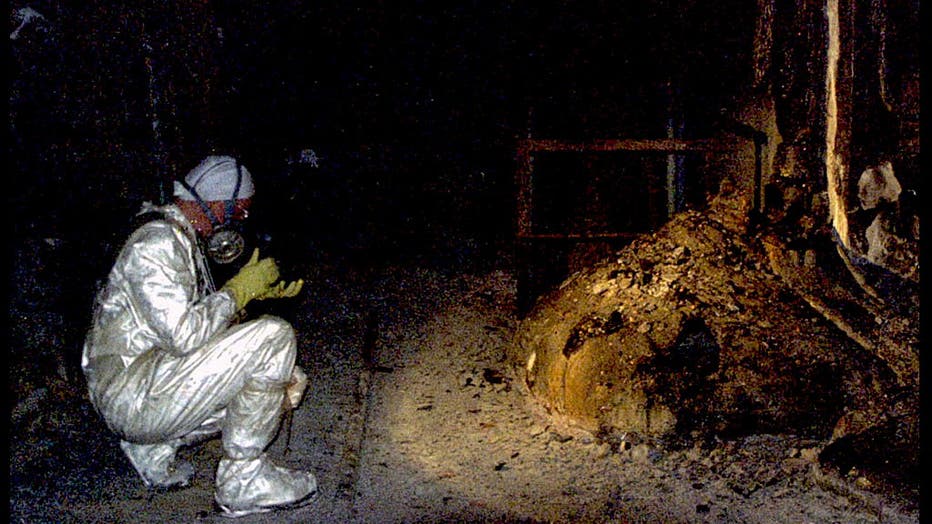
The "Elephant's Foot" of the Chernobyl disaster. In the immediate aftermath of the meltdown, a few minutes near this object, would bring certain death. Today, it is still radioactive, though its power has weakened. (Photo by Universal History Archive
On April 26, 1986, an explosion and fire at the Chernobyl nuclear power plant in Ukraine caused radioactive fallout that begin to spew into the atmosphere. Dozens of people were killed in the immediate aftermath of the disaster while the long-term death toll from radiation poisoning is believed to number in the thousands.
The Cold War relic sat largely disregarded for decades in the West — until Russia invaded Ukraine in 2022.
With scientists and others watching in disbelief from afar, Russian forces flew over the long-closed plant, ignoring the restricted airspace around it. They held personnel still working at the plant at gunpoint during a marathon shift of more than a month, with employees sleeping on tabletops and eating just twice a day.

Chernobyl radiation leak possible due to power loss: New details
The Chernobyl nuclear power plant in Ukraine has lost power after it was disconnected from the grid after Russian forces attacked in the area. The loss of power has lead to concerns among Ukrainian officials that radiation contamination could occur if the cooling of spent nuclear fuel stops.
Even weeks after the Russians left, "I need to calm down," the plant's main security engineer, Valerii Semenov, told The Associated Press. He worked 35 days straight, sleeping only three hours a night, rationing cigarettes and staying on even after the Russians allowed a shift change.
"I was afraid they would install something and damage the system," he said in an interview.
Fukushima disaster
A magnitude 9.0 earthquake that struck Japan on March 11, 2011 — one of the biggest on record — triggered a wall of water that swept far inland, destroying towns and causing meltdowns at the Fukushima Daiichi nuclear plant.
The days following the quake were terrifying for many in Japan and farther afield, as hydrogen explosions released radiation into the air and technicians worked furiously to try to cool the plant’s nuclear fuel by pumping in seawater.
There were concerns and confusion about the extent of meltdowns, and how far radiation might travel, including fears that Tokyo and even the U.S. west coast were at risk. Officials said they were not, but panicked shoppers as far away as China and Russia scrambled to stock up on goods they thought would protect them.
More than 18,000 people died, mostly in the tsunami, and nearly half a million people were displaced. The government recognizes another 3,700 — mostly from Fukushima prefecture — who died of causes linked to the disaster, such as stress.
Over a decade later, more than 40,000 people are still unable to return home, and areas near the wrecked plant are still off-limits due to contamination from the initial radiation fallout. Many in Japan have said that the country’s intense focus on physically rebuilding has at times ignored other healing that needed to be done.
The Associated Press contributed to this story. It was reported from Los Angeles.

